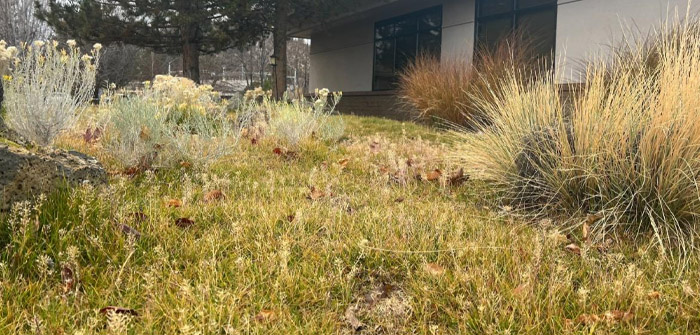(Photo courtesy of Volunteers in Medicine, Clinic of the Cascades)
As awareness of climate change and water shortages grows, many of us are taking a second look at our landscape choices. What once seemed to be a reasonable balance of verdant green to hardy dryland plants now feels a bit extravagant. The City of Bend’s 2024 turf rebate demonstrated in two weeks (the time it took for the program to max out for the year) that lawns and their impacts are at the top of everyone’s mind.
Eliminating lawns and establishing a native plant landscape is one good method of reducing water use in created landscapes. The High Desert Horticultural Center (HDHC) was recently established to advance the use of native plants for resource conservation in the high desert West. As a part of this mission, the HDHC recently partnered with Accent Landscaping and the City of Bend to create a water-wise and pollinator-friendly landscape for Volunteers in Medicine, Clinic of the Cascades (VIM).
Water-wise landscapes are clearly on the to-do list for local citizens and communities, but since there will always be a desire for play space in our yards, in our parks, and in other gathering areas, how can we at least mitigate impacts on our water resources and the local natural environment? Is using sod, widely marketed in Central Oregon, a poor decision? Do turf alternatives really save water? The truth is we don’t have a definitive answer — yet.
But Bend’s water resources department is aiming to find out. Dan Denning, the City of Bend’s Water Conservation Program Manager, has been working on the design of some turf test plots at the Volunteers in Medicine, Clinic of the Cascades (VIM) facility along with Chris Marrone, owner of Accent Landscaping and The Central Oregon Lawn Center. “We need baseline data on what would truly be a lower water-use turf option so informed recommendations can be made to homeowners and developers locally,” says Marrone.
The plan is to plant three 10’ x 10’ squares, each with these four seed mixes: Companion Mix (a low-maintenance dwarf grass mix), Turf-type tall fescue (a rhizomatous variety), Central Oregon Micro-lawn Mix (a micro clover and dwarf grass mix), and Ecoturf (a pollinator meadow mix of perennial flowering plants and fescues). Each of the three squares will be in separate irrigation zones. One plot will act as a control on a typical irrigation schedule; the other two with irrigation reduced by a consistent percentage. By tracking irrigation flows and soil moisture in the 12 plots over time, the potential water savings of these specific turf alternatives will be quantified. The results will provide valuable data for local governments as they evaluate code updates and respond to anticipated water resources legislation at the state level.
“We are excited to be the test-site for this project,” says Kat Mastrangelo, executive director at VIM. “As a healthcare facility with patients who are low-income and uninsured, we know that people’s physical environment impacts their overall health and well-being. This project will illustrate how a healthy, natural landscape can improve livability for all of us in Central Oregon.”
In the experiment’s first phase, the seed will go directly on existing soil without amendment (mimicking practices typical in most Central Oregon large-scale developments). Denning explains, “We’d also like to see how different management scenarios impact the species and contribute to more efficiency over time.” In the second phase, Denning and Marrone plan to re-seed over improved soil. If the alternatives to traditional turf prove to be as resilient and less reliant on precious water as they hope, they’ll have a strong case for their recommendation.
The project is underway, the High Desert Horticultural Center and Accent Landscaping set up plots and planted native foliage in mid-September of this year. While the project will take time to produce important data about the best landscaping for our natural environment and water conservation, project partners will provide regular updates to the community through social media. Like and follow High Desert Horticultural Center, Accent Landscape Design & Construction, and Volunteers in Medicine to see how the project develops.





